Gaomi Paper-CuttingIt is popular in Gaomi, Shandong Province and used as window and gate ornaments, box and case, and cupboard. It is directly cut on paper without draft pattern. It is characterized by the image in saw- toothed shape and straight line.
Binzhou Paper-Cutting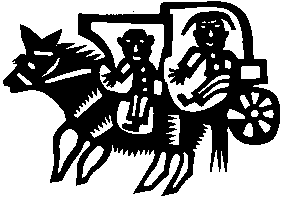
It is popular in Huiming Prefecture, Shandong Province and used as window ornament and embroidery pattern. It is more coarse than that of Jiaodong. It is characterized by folded figurine.
Wei County Paper-Cutting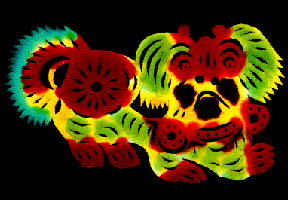
It is popular in Wei County, Hebei Province. It is famous for its window ornaments, of which Tianpiliang is the earliest form. This ornament is made by drawing and dyeing pictures on the thin chip. Then a type of water-printed woodblock window paper-cutting, originated in Wuqiang County in the same province, drew upon this feature in colour and transparency and came to unite with Shuipiliang window paper-cutting, which is characterized by the engraving instead of writing.Thus the distinctive feature of Wei County paper-cutting came into being.
Nanjing Paper-Cutting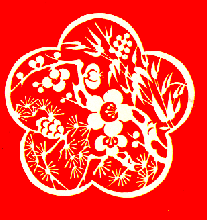
This type of paper-cutting is famous for its happy flower and Douxiang flower types. On the occasions of wedding and celebrations, Nanjingers like to decorate the dowry with paper-cutting artifacts made from scarlet red paper. Its pattern is filled up with propitious illustrations according to need and particular paper shapes. There are flower-in-flower, theme-in-theme and subtlety-in-brevity patterns. Deftness is highlighted in the naivety. The themes of Douxiang paper-cutting range from dramatic tales, historical legends, folklores to propitious patterns and flowers.
Pi County Paper-Cutting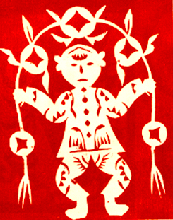
It is widely spread in Xuzhou, Jiangsu Province, particularly in Pi County. Its first type is colourful gate label. This type of paper -cutting is mainly used for decorating the windows. Its themes run the gamut of labouring scenes, domesticated animals, folklores, historical tales, etc.
Foshan Paper-CuttingIt is a type of folk paper-cutting in Foshan, Guangdong Province. It was in vogue in the Song Dynasty, and flourished in the Ming and Qing Dynasties. It is made by a way of scissor cutting, carving, chiselling, printing, writing, etc. The materials used are pure-colour paper, copper, golden colour paper,etc. It is cut and engraved with knife, scissors and copper utensil. A century ago,Foshan paper-cutting artifact served as the draft for architecture and furniture engraving. Later on it served as indoor decoration.
Taijiang Paper-Cutting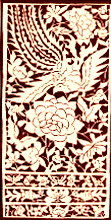
It is a type of Miao Nationality paper-cutting in Taijiang, Guizhou Province. It acts as the embroidery draft for decorating sleeve, girdle and hat. Though its themes are also dragon and phoenix, and peony, it is quitely distinguished from that of Han Nationality. Especially its paper-cutting for decoration sleeve is embroidered by needle and characterized by its fineness in roughness.
Leather Silhouette and Shadow PlayThis folk art is widely spread, which uses the folk handiworks: leather silhouette figure and highlighting background. It is said that shadow play originated in the Han Dynasty and became flourished in the Song Dynasty. Its popularity culminated in the Yuan Dynasty and spread to Persia.In the Ming and Qing Dynasties it was divided into many sects and spread to Java, Malaysia, Thailand, Burma and Japan, etc. Of the sects in the Qing Dynasty,Luanzhou shadow play is the most famous.While in performance, a curtain is hung against which a lamp or candle is lit. Behind the curtain the performer manipulate the silhouettes to act, accompanied by singing,reading lines and playing musical instruments. Some shadow play troupes are made up of singers, drum players and their assistants. The roles of the play are characterized into painted face, male, female, and comic role.
Beijing Shadow PlayIt is said that it emerged in the Ming Dynasty. This shadow play participated in the theatrical festival held in Beijing in 1503. It is also said that the shadow play was circulated into Hebei Province and finally reached Beijing. It is divided into the east and west sects. Not only acclaimed by farmers and citizens, it was also put on in the imperial palace. During the reign of Emperor Kangxi,an official ranking the fifth place was in charge of shadow play. Duringthe reign of Emperor Jiaqing, shadow play troupes were summoned to the imperial palace and give performance on Spring Festivals and happy occasions.At that time the shadow play troupes in Beijing performed puppets in the daytime and shadow play for home celebration at night. Many Beijing Opera actors also performed shadow play. Since the middle of the Qing Dynasty, it had borrowed facial masks from Beijing Opera.
Luanzhou Leather Silhouette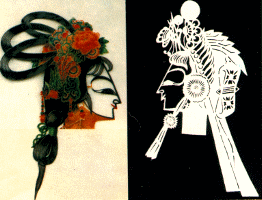
First it refers to the leather silhouette in Luan County, Hebei Province. Its performance was accompanied by the song sung in the tone of luoting. It also refers to the shadow play accompanied by the song sung in the tone of Liuqin Opera. Its engraving skill was characterized by roughness and antiquated colour.
 It is popular in Huiming Prefecture, Shandong Province and used as window ornament and embroidery pattern. It is more coarse than that of Jiaodong. It is characterized by folded figurine.
It is popular in Huiming Prefecture, Shandong Province and used as window ornament and embroidery pattern. It is more coarse than that of Jiaodong. It is characterized by folded figurine.  It is popular in Wei County, Hebei Province. It is famous for its window ornaments, of which Tianpiliang is the earliest form. This ornament is made by drawing and dyeing pictures on the thin chip. Then a type of water-printed woodblock window paper-cutting, originated in Wuqiang County in the same province, drew upon this feature in colour and transparency and came to unite with Shuipiliang window paper-cutting, which is characterized by the engraving instead of writing.Thus the distinctive feature of Wei County paper-cutting came into being.
It is popular in Wei County, Hebei Province. It is famous for its window ornaments, of which Tianpiliang is the earliest form. This ornament is made by drawing and dyeing pictures on the thin chip. Then a type of water-printed woodblock window paper-cutting, originated in Wuqiang County in the same province, drew upon this feature in colour and transparency and came to unite with Shuipiliang window paper-cutting, which is characterized by the engraving instead of writing.Thus the distinctive feature of Wei County paper-cutting came into being.  This type of paper-cutting is famous for its happy flower and Douxiang flower types. On the occasions of wedding and celebrations, Nanjingers like to decorate the dowry with paper-cutting artifacts made from scarlet red paper. Its pattern is filled up with propitious illustrations according to need and particular paper shapes. There are flower-in-flower, theme-in-theme and subtlety-in-brevity patterns. Deftness is highlighted in the naivety. The themes of Douxiang paper-cutting range from dramatic tales, historical legends, folklores to propitious patterns and flowers.
This type of paper-cutting is famous for its happy flower and Douxiang flower types. On the occasions of wedding and celebrations, Nanjingers like to decorate the dowry with paper-cutting artifacts made from scarlet red paper. Its pattern is filled up with propitious illustrations according to need and particular paper shapes. There are flower-in-flower, theme-in-theme and subtlety-in-brevity patterns. Deftness is highlighted in the naivety. The themes of Douxiang paper-cutting range from dramatic tales, historical legends, folklores to propitious patterns and flowers.  It is widely spread in Xuzhou, Jiangsu Province, particularly in Pi County. Its first type is colourful gate label. This type of paper -cutting is mainly used for decorating the windows. Its themes run the gamut of labouring scenes, domesticated animals, folklores, historical tales, etc.
It is widely spread in Xuzhou, Jiangsu Province, particularly in Pi County. Its first type is colourful gate label. This type of paper -cutting is mainly used for decorating the windows. Its themes run the gamut of labouring scenes, domesticated animals, folklores, historical tales, etc.  It is a type of Miao Nationality paper-cutting in Taijiang, Guizhou Province. It acts as the embroidery draft for decorating sleeve, girdle and hat. Though its themes are also dragon and phoenix, and peony, it is quitely distinguished from that of Han Nationality. Especially its paper-cutting for decoration sleeve is embroidered by needle and characterized by its fineness in roughness.
It is a type of Miao Nationality paper-cutting in Taijiang, Guizhou Province. It acts as the embroidery draft for decorating sleeve, girdle and hat. Though its themes are also dragon and phoenix, and peony, it is quitely distinguished from that of Han Nationality. Especially its paper-cutting for decoration sleeve is embroidered by needle and characterized by its fineness in roughness.  First it refers to the leather silhouette in Luan County, Hebei Province. Its performance was accompanied by the song sung in the tone of luoting. It also refers to the shadow play accompanied by the song sung in the tone of Liuqin Opera. Its engraving skill was characterized by roughness and antiquated colour.
First it refers to the leather silhouette in Luan County, Hebei Province. Its performance was accompanied by the song sung in the tone of luoting. It also refers to the shadow play accompanied by the song sung in the tone of Liuqin Opera. Its engraving skill was characterized by roughness and antiquated colour.


 已有
已有













